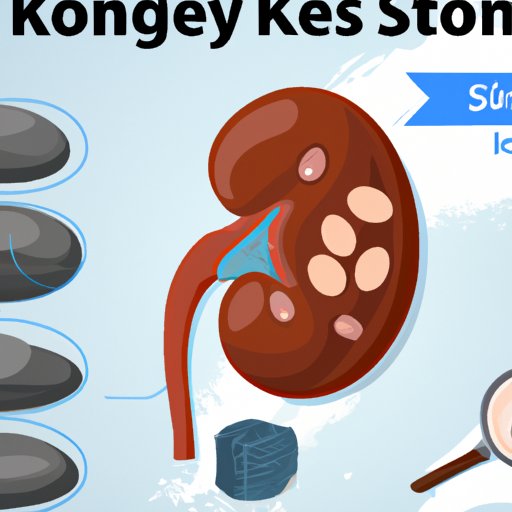
I. Introduction
Kidney stones are a common condition that affects approximately 1 in 10 people at some point in their lifetime. These small, hard deposits form in the kidneys or urinary tract and can cause severe pain and discomfort. While kidney stones are treatable, it’s important to diagnose them early to prevent complications. In this article, we’ll explore how to recognize the symptoms of kidney stones and discuss the different types of tests used to diagnose this condition. We’ll also debunk common misconceptions and highlight the importance of seeking help from a healthcare provider.
II. How to Recognize the Symptoms of Kidney Stones: An Overview for Beginners
The symptoms of kidney stones can vary depending on the size and location of the stone, but most people experience pain or discomfort in the back, side, or groin. Other common symptoms include:
- Painful urination
- Blood in the urine
- Nausea or vomiting
- Frequent urination
If you’re experiencing any of these symptoms, it’s important to see a healthcare provider as soon as possible. Delayed diagnosis and treatment can lead to complications such as infection or kidney damage.
III. Different Types of Tests for Kidney Stones: Which One is Right for You?
There are several different tests available for diagnosing kidney stones. These include:
- Ultrasound
- CT scan
- X-ray
- Intravenous pyelogram (IVP)
- Blood tests
Each type of test has its own pros and cons, and the most appropriate test for you will depend on several factors, including the size and location of the stone, your medical history, and your symptoms. Your healthcare provider will work with you to determine which test is right for you.
IV. Common Misconceptions about Diagnosing Kidney Stones: What to Know
There are several common misconceptions about diagnosing kidney stones that can lead to delayed treatment. These include:
- “Only older men get kidney stones.”
- “Kidney stones don’t cause any symptoms.”
- “Drinking more water won’t help pass a kidney stone.”
It’s important to know the truth behind these misconceptions to ensure that you seek help early if you suspect you have kidney stones. For example, while kidney stones are more common in men over 40, anyone can develop them. Additionally, many people experience symptoms such as pain or discomfort, and staying hydrated can help prevent kidney stones from forming in the first place.
V. Discovering the Role of Ultrasound in Diagnosing Kidney Stones
Ultrasound is a non-invasive imaging test that uses high-frequency sound waves to create pictures of the inside of the body. This test is often used to diagnose kidney stones because it can help healthcare providers determine the size and location of stones in the urinary tract. Ultrasound is also safe and doesn’t expose patients to any radiation.
While ultrasound is a useful tool for diagnosing kidney stones, it does have some limitations. For example, it may not be able to detect very small stones or stones in certain locations. Your healthcare provider will consider these limitations when deciding whether an ultrasound is appropriate for you.
VI. CT Scans and X-Rays: How They Help Diagnose Kidney Stones
CT scans and X-rays are also commonly used to diagnose kidney stones. These tests use ionizing radiation to create images of the inside of the body.
X-rays are often used initially to diagnose kidney stones because they are quick and relatively inexpensive. However, they may not be able to detect smaller stones or stones in certain locations.
CT scans are more sensitive and can detect smaller stones or stones in hard-to-reach places. However, they expose patients to a higher amount of radiation than X-rays and may not be appropriate for everyone. Your healthcare provider will weigh the benefits and risks of each test to determine which one is right for you.
VII. The Importance of Visiting a Urologist for Diagnosing and Treating Kidney Stones
Urologists are specialists who are trained to diagnose and treat conditions that affect the urinary tract and male reproductive system, including kidney stones. If you suspect you have kidney stones or have been diagnosed with this condition, it’s important to see a urologist for specialized care.
Urologists have access to the latest diagnostic tools and treatments for kidney stones, and can work with you to develop a personalized treatment plan. They can also help you manage any complications that may arise from this condition, such as infections or blockages.
VIII. From Home Remedies to Medical Intervention: A Guide to Diagnosing and Treating Kidney Stones
Treatment for kidney stones will depend on several factors, including the size and location of the stone and your symptoms. In some cases, home remedies such as drinking lots of water and using over-the-counter pain relievers may be enough to help the stone pass naturally.
However, if your stone is large or causing severe symptoms, medical intervention may be necessary. This can include procedures such as extracorporeal shock wave lithotripsy (ESWL) or ureteroscopy.
It’s important to follow up with your healthcare provider after treatment to ensure that the stone has passed and to prevent future stones from forming.
IX. Conclusion
Kidney stones can be a painful and uncomfortable condition, but with early diagnosis and treatment, they can be successfully managed. By recognizing the symptoms and seeking help from a healthcare provider, you can get the care you need to prevent complications and promote a healthy urinary system.
Remember, if you suspect you have kidney stones, don’t hesitate to seek help from a healthcare provider. With the right diagnosis and treatment, you can get back to feeling your best.




